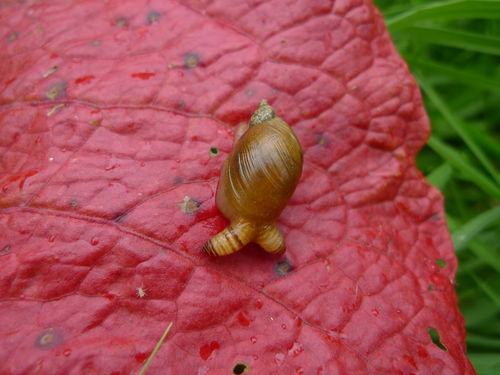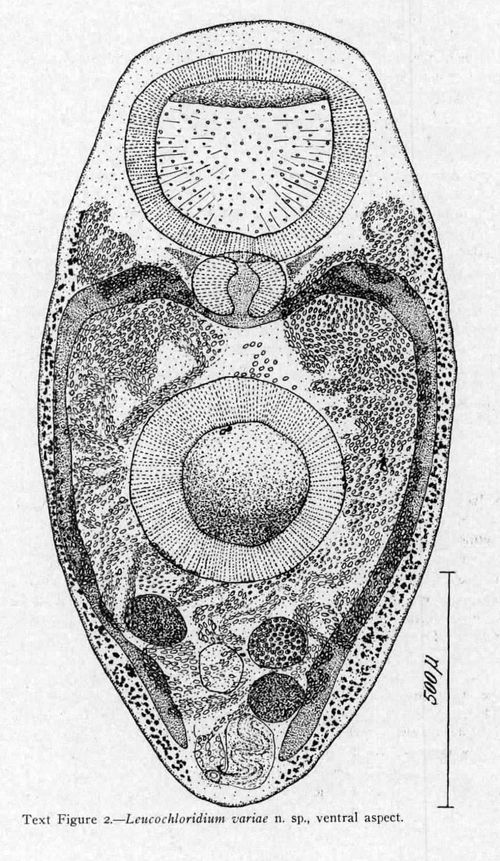Succinea putris (L) parasitised by Leucochloridium at Pershore, Worcestershire
Mike Poulton & Paul Reade
Zombie Snail
On the afternoon of 3rd June 2014, we were walking through the riverside meadow off Cherry Orchard, in Pershore, Grid Ref.SO951461, when our attention was drawn to a very conspicuous, odd looking semi-aquatic snail (possibly Oxyloma pfeifferi or Succinea putris) sitting on the upper surface of a rather reddish dock Rumex obtusifolia leaf. On closer inspection it became apparent that both eye tentacles were extremely swollen and made up of concentric brownish-coloured bands which appeared to be ‘pulsating’ rhythmically, very much resembling two wriggling maggots. Several photographs and a short video were taken with the intention of later researching the subject on the internet. The search led us to a snail parasite called Leucochloridium variae, common name Brown-banded Broodsac or one of the similar Leucochloridium species. When the parasite has matured within the snail, indicated by its movement into an eye tentacle, it then alters the behaviour of the snail such that the snail now climbs up into the vegetation, into light and into the open, in effect offering itself as dinner to the first passing bird. The foraging bird rips off the eye stalk and eats it, infecting itself with the parasite and completing the life cycle when the parasite's egg is dropped with the bird's faeces and is subsequently eaten by another snail. In this way the parasite increases its chance of reaching isolated populations of snails a far greater distance away.
Picture
01. Leucochloridium variae, common name Brown-banded Broodsac - Pershore riverside meadow 03-06-14.
There is plenty written on detailed aspects of the parasite itself and there are some fascinating, though somewhat gruesome videos to be seen on the internet but it is difficult to find any information about its distribution, particularly in the British Isles. Has anyone else come across the ‘Zombie Snail’ in Worcestershire or for that matter anywhere else in the British Isles?
The picture was sent to Adrian Norris of the Conchological Society of Great Britain & Ireland who commented:
“The snail is Succinea putris and the parasite is very well known, but little observed. The parasite is usually found in this species and is noticed by people who frequent the marshy areas in which the snail lives”.
Editor’s note
I was fascinated by this note from Messrs. Poulton & Reade and the picture which stimulated an old interest in parasites and I spent a lot of time trying to find out more about this one. The pulsating tentacles are part of the life cycle of a trematode (flatworm) and there are many flatworm species with life cycles involving snails and birds or mammals (including unpleasant diseases in people). There are many species infecting many birds and the mature flatworm resides in the gut, especially the cloaca from whence its eggs reach the outside world. The following description outlines the life cycle:
“Leucochloridium Adults live in the cloaca of various birds. Eggs already contain a miracidium when they pass in the faeces of the bird. These eggs can resist environmental conditions if deposited on land. They do not hatch until eaten by a suitable snail. Once in the gut of the snail, the egg hatches and releases the miracidium, which immediately penetrates the gut and enters the tissues of the snail. A mother sporocyst develops, which produces many daughter sporocysts. When the daughter sporocysts have produced cercariae, the sporocysts extend branches into the tentacles of the snail, and the cercariae transform into metacercariae. These sporocyst branches have colored bands and also pulsate. They are quite large, and the pulsating colored tentacles of the infected snails attract predation by birds. The metacercariae are ingested by the bird and develop into adults.” http://www2.biology.ualberta.ca/parasites/ParPub/lifecycl/text/strig04t.htm
Although parasitology texts frequently mention that the pulsating tentacles are taken by birds I have so far been unable to trace the original report of this for the parasite in Succinea putris. Which bird species attacks the tentacles? The snail lives in damp marshy habitats and is quite small so perhaps a small bird takes the tentacles or does a larger bird simply eat the whole snail? The answer may be in C. A. Heckert. 'Monographische Darstellung der Entwicklungs und Lebensgeschichte des Distomum macroslomum', in Leuckart and Chun's Bibliotheca Zooiogica. iv (Cassel, 1889) which referenced by Ellis (1926) after he describes the process. Lapage (1958) makes a similar comment without references suggesting that authors sometimes repeat other author’s comments without recourse to the original description. Baer (1951) has a description and a drawing and refers to Wesenberg-Lund but fails to give details of the reference.
The original descripton of the flat worm itself Leucochloridium variae (McIntosh 1932) was of one found in the cloaca of a Black and White Warbler Mniotilta varia in North America. This is a migratory forest bird breeding in NE of North America and wintering in N South America. They can be found in many habitats during migration, especially woodlands and forests in riparian settings so it is at times found near wetlands. (http://www.allaboutbirds.org/guide/black-and-white_warbler). The worm may of course parasitise other species in other parts of the world.
Internet searches find many papers on details of the parasite, its genetics and so on but next to nothing on natural history. The following paper may be useful but so far I haven’t been able to see it: Arthur Erskine Ellis, 1950, Succinea putris (L.) parasitized by Leucochloridium . Journal of Conchology 23:107.
My apologies to Mike Poulton and Paul Reade for adding comments as long as their note but I hope this may stimulate readers to look for this snail and its parasite. If anyone finds one please take pictures. Also if anyone can dig out more information on the natural history please let us know. Meanwhile http://imgur.com/gallery/TOBBI has some remarkable video of pulsating antennae!
References
Baer, J.G. 1951. Ecology of animal parasites. University of Illinois Press. Urbana.
Ellis, A.E. 1926, 1969 impression. British Snails. Clarendon Press, Oxford.
Lapage, G. 1958. Parasitic animals. Heffer & Sons, Cambridge.
McIntosh, A. 1932 Some new species of Trematode worms of the genus Leucochloridium, Carus, parasitic in birds from northern Michigan, with a key and notes on other species of the genus. Journal of Parasitology 19:32-48
Images
01. Leucochloridium variae Brown-banded Broodsac.
02. Leucochloridium variae from McIntosh 1932

